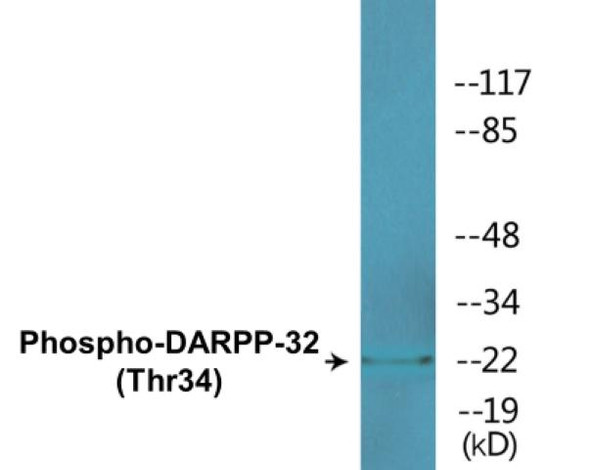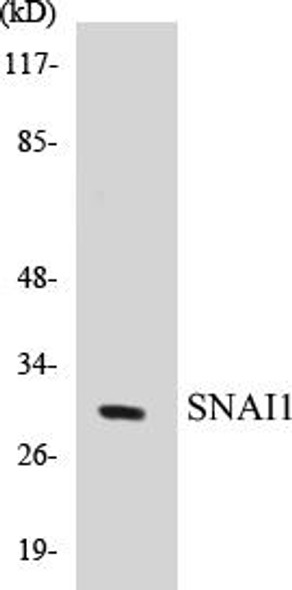Description
DARPP-32 Colorimetric Cell-Based ELISA Kit
The DARPP-32 Colorimetric Cell-Based ELISA Kit is a cutting-edge tool for researchers looking to accurately measure DARPP-32 protein levels in cell lysates or tissue homogenates. With its high sensitivity and specificity, this kit provides reliable and reproducible results, making it an essential asset for studying the role of DARPP-32 in various cellular processes.DARPP-32, also known as Dopamine- and cAMP-regulated phosphoprotein, is a key signaling molecule involved in regulating dopamine neurotransmission.
Dysregulation of DARPP-32 has been implicated in several neuropsychiatric disorders, including schizophrenia and Parkinson's disease. By using this ELISA kit, researchers can gain valuable insights into the role of DARPP-32 in these disorders and potentially identify new therapeutic targets.Overall, the DARPP-32 Colorimetric Cell-Based ELISA Kit is a valuable tool for researchers looking to further their understanding of DARPP-32 function and its potential implications in human health and disease.
| Product Name: | DARPP-32 Colorimetric Cell-Based ELISA Kit |
| Product Code: | CBCAB00620 |
| ELISA Type: | Cell-Based |
| Target: | DARPP-32 |
| Reactivity: | Human, Mouse, Rat |
| Dynamic Range: | > 5000 Cells |
| Detection Method: | Colorimetric 450 nmStorage/Stability:4°C/6 Months |
| Format: | 96-Well Microplate |
The DARPP-32 Colorimetric Cell-Based ELISA Kit is a convenient, lysate-free, high throughput and sensitive assay kit that can detect DARPP-32 protein expression profile in cells. The kit can be used for measuring the relative amounts of DARPP-32 in cultured cells as well as screening for the effects that various treatments, inhibitors (ie siRNA or chemicals), or activators have on DARPP-32.
Qualitative determination of DARPP-32 concentration is achieved by an indirect ELISA format. In essence, DARPP-32 is captured by DARPP-32-specific primary antibodies while the HRP-conjugated secondary antibodies bind the Fc region of the primary antibody. Through this binding, the HRP enzyme conjugated to the secondary antibody can catalyze a colorimetric reaction upon substrate addition. Due to the qualitative nature of the Cell-Based ELISA, multiple normalization methods are needed:
| 1. | A monoclonal antibody specific for human GAPDH is included to serve as an internal positive control in normalizing the target absorbance values. |
| 2. | Following the colorimetric measurement of HRP activity via substrate addition, the Crystal Violet whole-cell staining method may be used to determine cell density. After staining, the results can be analysed by normalizing the absorbance values to cell amounts, by which the plating difference can be adjusted. |
| Database Information: | Gene ID: 84152, UniProt ID: Q9UD71, OMIM: 604399, Unigene: Hs.286192 |
| Gene Symbol: | PPP1R1B |
| Sub Type: | None |
| UniProt Protein Function: | DARPP-32: a member of the protein phosphatase inhibitor 1 family. A dopamine- and cyclic AMP-regulated neuronal phosphoprotein. Both dopaminergic and glutamatergic (NMDA) receptor stimulation regulate the extent of DARPP32 phosphorylation, but in opposite directions. Dopamine D1 receptor stimulation enhances cAMP formation, resulting in the phosphorylation of DARPP32; phosphorylated DARPP32 is a potent protein phosphatase-1 inhibitor. NMDA receptor stimulation elevates intracellular calcium, which leads to activation of calcineurin and dephosphorylation of phospho-DARPP32, thereby reducing the phosphatase-1 inhibitory activity of DARPP32. Two alternatively-spliced isoforms have been described. |
| UniProt Protein Details: | Protein type:Motility/polarity/chemotaxis; Protein phosphatase, regulatory subunit Chromosomal Location of Human Ortholog: 17q12 Cellular Component: cell soma; cytoplasm; cytosol; nucleus Molecular Function:D1 dopamine receptor binding; D2 dopamine receptor binding; D3 dopamine receptor binding; D4 dopamine receptor binding; D5 dopamine receptor binding; protein binding; protein kinase inhibitor activity; protein phosphatase inhibitor activity; protein phosphatase type 1 regulator activity; type 1 serine/threonine specific protein phosphatase inhibitor activity Biological Process: negative regulation of catalytic activity; negative regulation of female receptivity; regulation of catalytic activity; response to amphetamine; signal transduction; transcription, DNA-dependent; visual learning |
| NCBI Summary: | This gene encodes a bifunctional signal transduction molecule. Dopaminergic and glutamatergic receptor stimulation regulates its phosphorylation and function as a kinase or phosphatase inhibitor. As a target for dopamine, this gene may serve as a therapeutic target for neurologic and psychiatric disorders. Multiple transcript variants encoding different isoforms have been found for this gene. [provided by RefSeq, Oct 2011] |
| UniProt Code: | Q9UD71 |
| NCBI GenInfo Identifier: | 23831292 |
| NCBI Gene ID: | 84152 |
| NCBI Accession: | Q9UD71.2 |
| UniProt Secondary Accession: | Q9UD71,Q547V9, Q547W0, Q9H7G1, |
| UniProt Related Accession: | Q9UD71 |
| Molecular Weight: | 18,738 Da |
| NCBI Full Name: | Protein phosphatase 1 regulatory subunit 1B |
| NCBI Synonym Full Names: | protein phosphatase 1 regulatory inhibitor subunit 1B |
| NCBI Official Symbol: | PPP1R1B |
| NCBI Official Synonym Symbols: | DARPP32; DARPP-32 |
| NCBI Protein Information: | protein phosphatase 1 regulatory subunit 1B |
| UniProt Protein Name: | Protein phosphatase 1 regulatory subunit 1B |
| UniProt Synonym Protein Names: | DARPP-32; Dopamine- and cAMP-regulated neuronal phosphoprotein |
| Protein Family: | Protein phosphatase 1 regulatory |
| UniProt Gene Name: | PPP1R1B |
| UniProt Entry Name: | PPR1B_HUMAN |
| Component | Quantity |
| 96-Well Cell Culture Clear-Bottom Microplate | 2 plates |
| 10X TBS | 24 mL |
| Quenching Buffer | 24 mL |
| Blocking Buffer | 50 mL |
| 15X Wash Buffer | 50 mL |
| Primary Antibody Diluent | 12 mL |
| 100x Anti-Phospho Target Antibody | 60 µL |
| 100x Anti-Target Antibody | 60 µL |
| Anti-GAPDH Antibody | 60 µL |
| HRP-Conjugated Anti-Rabbit IgG Antibody | 12 mL |
| HRP-Conjugated Anti-Mouse IgG Antibody | 12 mL |
| SDS Solution | 12 mL |
| Stop Solution | 24 mL |
| Ready-to-Use Substrate | 12 mL |
| Crystal Violet Solution | 12 mL |
| Adhesive Plate Seals | 2 seals |
The following materials and/or equipment are NOT provided in this kit but are necessary to successfully conduct the experiment:
- Microplate reader able to measure absorbance at 450 nm and/or 595 nm for Crystal Violet Cell Staining (Optional)
- Micropipettes with capability of measuring volumes ranging from 1 µL to 1 ml
- 37% formaldehyde (Sigma Cat# F-8775) or formaldehyde from other sources
- Squirt bottle, manifold dispenser, multichannel pipette reservoir or automated microplate washer
- Graph paper or computer software capable of generating or displaying logarithmic functions
- Absorbent papers or vacuum aspirator
- Test tubes or microfuge tubes capable of storing ≥1 ml
- Poly-L-Lysine (Sigma Cat# P4832 for suspension cells)
- Orbital shaker (optional)
- Deionized or sterile water
*Note: Protocols are specific to each batch/lot. For the correct instructions please follow the protocol included in your kit.
| Step | Procedure |
| 1. | Seed 200 µL of 20,000 adherent cells in culture medium in each well of a 96-well plate. The plates included in the kit are sterile and treated for cell culture. For suspension cells and loosely attached cells, coat the plates with 100 µL of 10 µg/ml Poly-L-Lysine (not included) to each well of a 96-well plate for 30 minutes at 37°C prior to adding cells. |
| 2. | Incubate the cells for overnight at 37°C, 5% CO2. |
| 3. | Treat the cells as desired. |
| 4. | Remove the cell culture medium and rinse with 200 µL of 1x TBS, twice. |
| 5. | Fix the cells by incubating with 100 µL of Fixing Solution for 20 minutes at room temperature. The 4% formaldehyde is used for adherent cells and 8% formaldehyde is used for suspension cells and loosely attached cells. |
| 6. | Remove the Fixing Solution and wash the plate 3 times with 200 µL 1x Wash Buffer for five minutes each time with gentle shaking on the orbital shaker. The plate can be stored at 4°C for a week. |
| 7. | Add 100 µL of Quenching Buffer and incubate for 20 minutes at room temperature. |
| 8. | Wash the plate 3 times with 1x Wash Buffer for 5 minutes each time. |
| 9. | Add 200 µL of Blocking Buffer and incubate for 1 hour at room temperature. |
| 10. | Wash 3 times with 200 µL of 1x Wash Buffer for 5 minutes each time. |
| 11. | Add 50 µL of 1x primary antibodies (Anti-DARPP-32 Antibody and/or Anti-GAPDH Antibody) to the corresponding wells, cover with Parafilm and incubate for 16 hours (overnight) at 4°C. If the target expression is known to be high, incubate for 2 hours at room temperature. |
| 12. | Wash 3 times with 200 µL of 1x Wash Buffer for 5 minutes each time. |
| 13. | Add 50 µL of 1x secondary antibodies (HRP-Conjugated AntiRabbit IgG Antibody or HRP-Conjugated Anti-Mouse IgG Antibody) to corresponding wells and incubate for 1.5 hours at room temperature. |
| 14. | Wash 3 times with 200 µL of 1x Wash Buffer for 5 minutes each time. |
| 15. | Add 50 µL of Ready-to-Use Substrate to each well and incubate for 30 minutes at room temperature in the dark. |
| 16. | Add 50 µL of Stop Solution to each well and read OD at 450 nm immediately using the microplate reader. |
(Additional Crystal Violet staining may be performed if desired – details of this may be found in the kit technical manual.)






